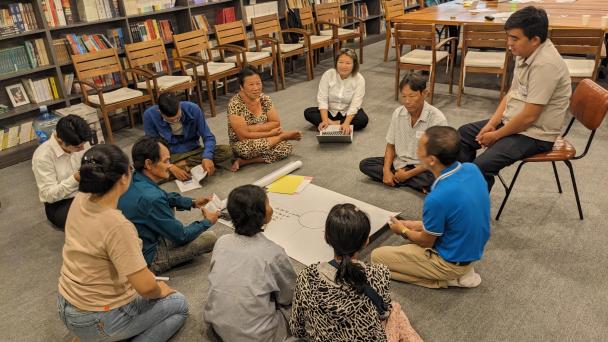Young people’s experiences of education during COVID

The effects of the pandemic can be seen throughout society, among all ages ‘from the cradle to the grave’, and are likely to be felt for decades to come, says a new report by the National Centre for Social Research (NatCen).
The Society Watch 2022 report brings together both existing and previously unpublished research and statistics to explore the possible legacies of the pandemic for society in Britain.
New research by NatCen for the report has found that women are now twice as likely as men to be extremely worried about life in the ‘new normal’.
The wider report highlights that the pandemic impacted all age groups and areas of society, posing significant challenges to both the national recovery and the government’s agenda to ‘level up’ the United Kingdom.
Guy Goodwin, Chief Executive of the National Centre for Social Research, said: “As the number of deaths from the virus recede and other challenges loom larger than COVID-19, many might think that the pandemic ‘is all over’. The national datasets and new research by NatCen for this report tell a different story. From impacts on education and healthcare to worsening diets and increased social isolation, we can observe that the effects of the pandemic are ongoing and likely to be felt for decades to come. Our research identifies a new ‘worry gap’ that has opened between women and men. This is one possible legacy of the pandemic, and a concerning example of how inequalities have either appeared or worsened during the crisis.”
The report examines the experience of the pandemic for all age groups, looking at its ongoing impacts throughout the course of our lives, in areas including education, work, social connections and mental and physical health. Key insights include:
Young people experienced a disruption to education with a disproportionally negative effect on the learning environment and attainment of students from disadvantaged groups.
Children and young people’s mental health worsened over the pandemic, with more children experiencing a probable mental health problem.
Similarly, adults reported a worsening of their mental health during the pandemic. Women, those struggling financially and people working from home and living alone experienced worse mental health outcomes.
Since the pandemic, more people have reported struggling with paying their bills and there appears to be more overcrowding, particularly in the private rented sector. The cost of living crisis could amplify these issues further.
General health may be negatively affected as well, with people reporting to exercise less and drink more alcohol.
In later life, increasing loneliness and isolation has negatively impacted wellbeing and mental health. Health conditions have been identified later or not identified, and many have reported a worse financial situation in later life.
New research by NatCen for the report highlights that, between January 2019 and January 2022, women became far more likely than men to report worries about their work-life balance, education and their parents’ and children’s wellbeing.
NatCen researchers found that, in January 2022, almost two years after the onset of the pandemic, women in Britain were twice as likely as men to report they were ‘extremely worried’ about most life areas they were asked about. There was little difference in levels of worry between women and men before the pandemic, in 2018 and 2019.
Speaking about NatCen’s new research into levels of worry in Britain, Josefien Breedvelt, Director of Analysis at the National Centre for Social Research, said: “While overall levels of worry appear to be the same in 2022 as they were pre-pandemic, this conceals a stark ‘worry gap’ that has opened up between women and men. The pandemic increased the burden on many women who often had to deal with additional caring pressures, while many female-dominated sectors from care work to the service industry were particularly badly hit.
Women may still be experiencing a greater impact from the ongoing legacy and stress that the pandemic brought about. If ongoing challenges from the pandemic and the cost of living crisis fall disproportionately on women, we may see an even greater divergence in levels of worry between men and women in Britain.”
NatCen’s Society Watch 2022 report and the accompanying briefing paper exploring levels of worry in Britain since the pandemic will be published at 00:01am on Thursday 14 July at www.natcen.ac.uk/society-watch-2022.
For more information please contact:
Oliver Paynel, Communications Manager, National Centre for Social Research
oliver.paynel@natcen.ac.uk
Direct: 0207 549 9550
Mobile: 07734 960 071
Katie Crabb, Head of Marketing and Communications, National Centre for Social Research
katie.crabb@natcen.ac.uk
Direct: 0207 549 8504
1. The National Centre for Social Research (NatCen), Britain’s largest independent social research organisation, aims to promote a better-informed society through high quality social research (www.natcen.ac.uk).
2. Society Watch 2022 provides a snapshot of the public’s experiences of the pandemic from some of the UK’s national data sources. It does not attempt to be a comprehensive record because of the scale of research that continues to be undertaken and the changing nature of the pandemic.
3. NatCen’s new research into levels of worry in Britain before and since the pandemic is based on based on three surveys conducted via the NatCen Panel with a nationally representative sample of adults aged 18+ in Great Britain at three different time points, in January 2018 (2,199 adults), January 2019 (2,048 adults) and January 2022 (1,122 adults).
4. The NatCen Panel comprises people who were originally interviewed (face to face) as part of NatCen’s annual British Social Attitudes survey, and who have agreed to answer occasional follow-up surveys either online or on the phone.

 Press release
Press release


Receive a regular update, sent directly to your inbox, with a summary of our current events, research, blogs and comment.
Subscribe